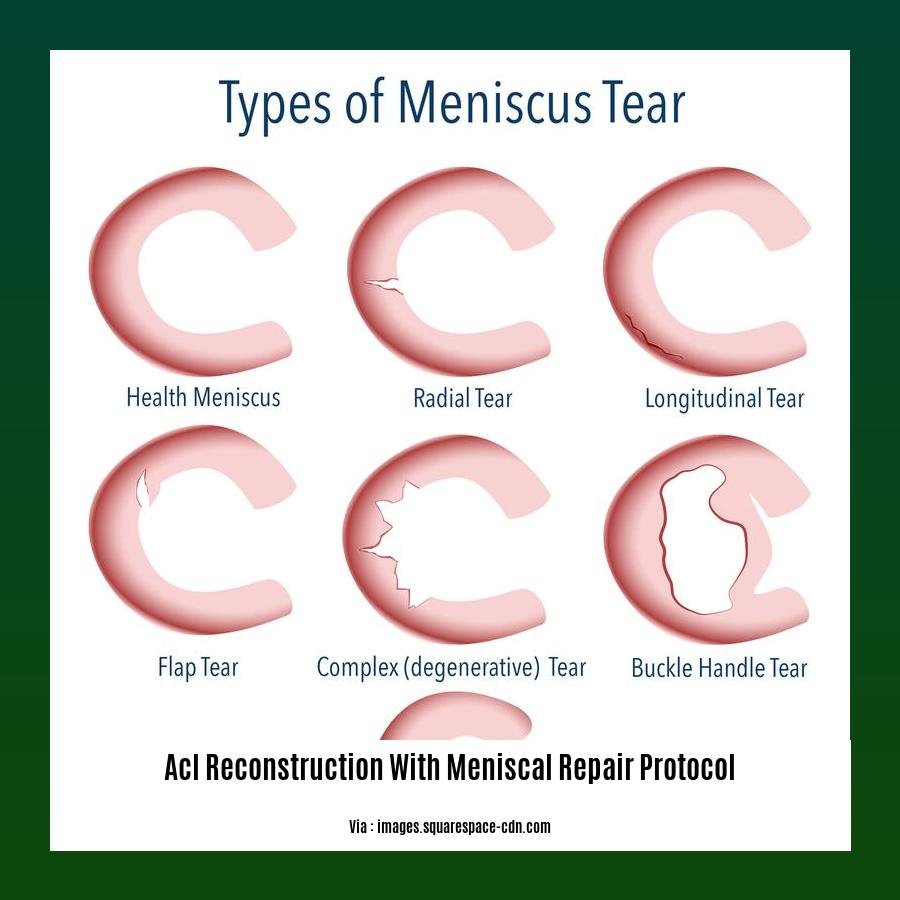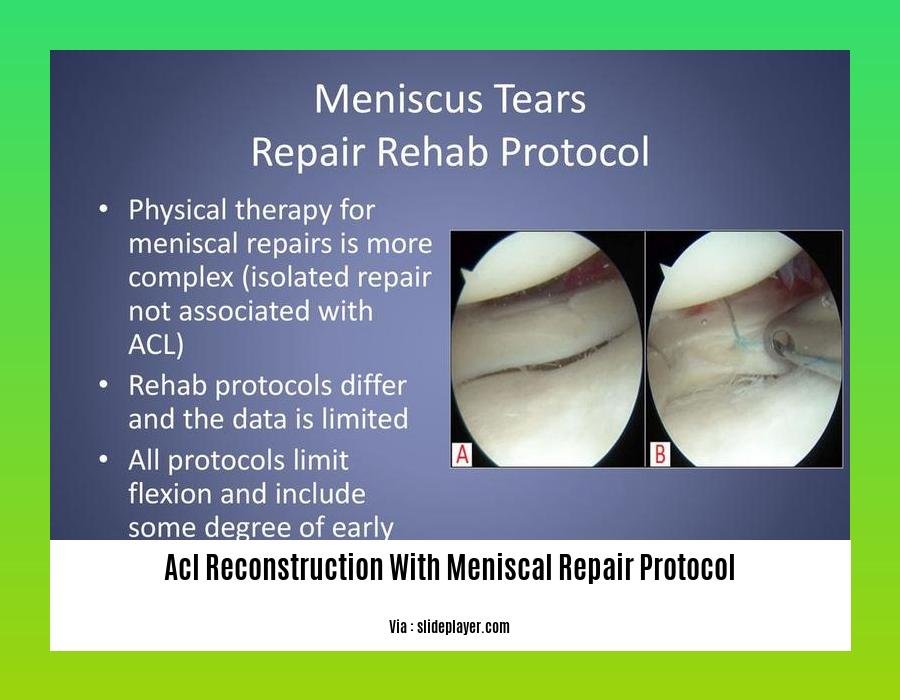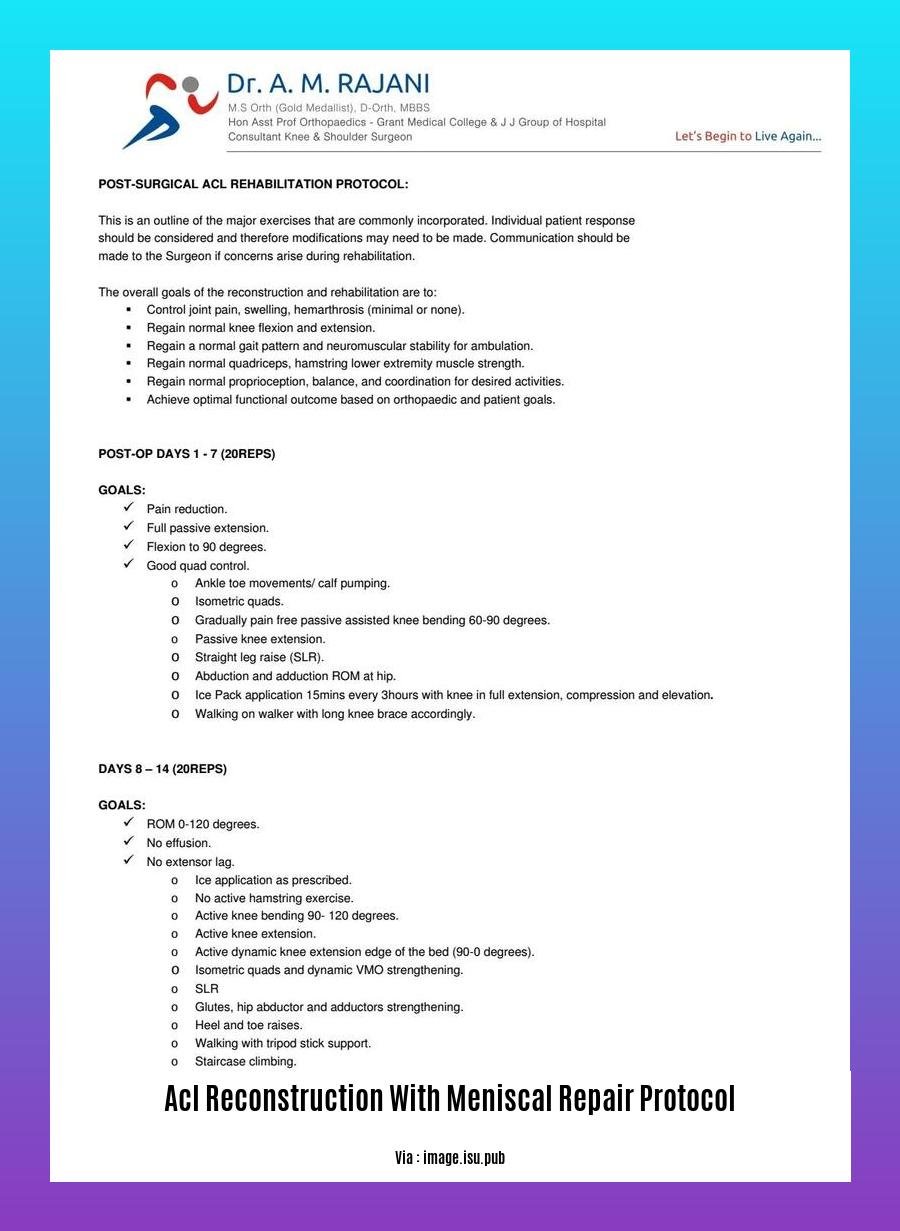[ACL Reconstruction with Meniscal Repair Protocol: A Comprehensive Guide] is designed to guide patients through the complex rehabilitation process following ACL reconstruction surgery with meniscal repair. This protocol provides a step-by-step approach to recovery, with detailed explanations of each phase and precautions to ensure optimal outcomes. Whether you’re a patient, physical therapist, or healthcare professional, this guide empowers you with the knowledge and resources to facilitate a successful recovery.
Key Takeaways:
- Restrict passive range of motion to 90 degrees or less for 4 weeks.
- Avoid squatting or excessive knee bending for 6 months.
- Delay deep squats for 6-9 months.
- Implement meniscal repair protocol.
- Use crutches with toe-touch weight-bearing for the first 2 weeks.
- Follow ACL rehabilitation protocol, avoiding open kinetic hamstring strengthening for 6 weeks with ACL reconstruction and meniscal repair/transplant.
- Extend brace and crutch usage as recommended by the doctor.
- Engage in supervised physical therapy for 3-9 months.
ACL Reconstruction with Meniscal Repair Protocol

Following an ACL reconstruction with meniscal repair protocol is crucial for a successful recovery. Here’s a comprehensive guide:
Post-Surgery Phase:
- Weeks 0-4: Progressive weight-bearing with crutches, no PROM exceeding 90 degrees.
- Weeks 4-6: Continue with weight-bearing exercises, incorporate gentle ROM exercises.
- Month 3: Gradually increase ROM, begin light strengthening exercises.
Meniscal Repair Protocol:
- Avoid deep squats for 6-9 months.
- Follow the ACL protocol with no open kinetic hamstring strengthening for 6 weeks.
- Use a brace and crutches as per physician’s instructions.
Physical Therapy:
- Supervised physical therapy sessions for 3-9 months.
- Focus on restoring ROM, strength, and stability.
- Gradual progression of exercises based on individual recovery.
Safety Precautions:
- No squatting or hyperflexion for 6 months.
- Avoid twisting or pivoting movements.
- Listen to your body and rest when needed.
Importance of Adherence:
- Following the protocol diligently optimizes healing and minimizes the risk of complications.
- Regular physical therapy sessions are essential for effective rehabilitation.
- Patience and perseverance are key to a successful recovery.
Remember, every individual’s recovery journey is unique. Your surgeon and physical therapist will provide personalized guidance based on your specific case.
To get started on your rehab exercises, you can find plenty of helpful resources here. Also, If you’re preparing for ACL surgery, you can look at the pain timeline to know what to expect. Getting ACL surgery privately in the UK can be expensive, so it’s a good idea to check out the cost before you commit. Finally, if you’re curious about the recovery time for dogs after ACL surgery, you can read more here.
Anterior Cruciate Ligament Injury Overview

Key Takeaways:
- ACL injuries commonly occur during sports that involve sudden twisting or pivoting movements.
- ACL tears often cause instability, pain, and reduced range of motion in the knee.
- ACL reconstruction is a surgical procedure to repair the torn ligament and restore knee stability.
- Meniscus injuries often accompany ACL tears and may require additional repair during surgery.
- Postoperative rehabilitation for ACL reconstruction with meniscus repair involves gradual progression of exercises to regain knee function and prevent complications.
What is the Anterior Cruciate Ligament (ACL)?
The ACL is a strong ligament that connects the femur (thigh bone) to the tibia (shin bone) within the knee joint. It helps stabilize the knee and prevents excessive forward movement of the tibia.
Causes of ACL Injuries
ACL injuries usually occur during sports activities that involve sudden changes in direction, such as pivoting, jumping, or landing from a jump. They can also happen due to direct contact injuries, such as a tackle in football.
Symptoms of ACL Injuries
The most common symptom of an ACL injury is a popping or snapping sound followed by immediate pain and swelling in the knee. Other symptoms may include:
- Instability in the knee
- Difficulty walking or running
- Pain with twisting or pivoting movements
- Reduced range of motion
- Feeling of the knee “giving way”
Treatment for ACL Injuries
The main treatment for a torn ACL is surgical reconstruction. The procedure involves replacing the torn ligament with a graft from another part of the body, such as the patellar tendon or hamstring tendons.
Post-Operative Rehabilitation for ACL Reconstruction with Meniscus Repair
After surgery, a rehabilitation program is essential to restore knee function and prevent complications. The rehabilitation protocol typically involves the following steps:
- Weeks 0-6: Rest, ice, compression, and elevation (RICE) to reduce swelling and pain.
- Weeks 6-12: Gradual increase in range of motion exercises and strengthening exercises to rebuild muscle strength and stability.
- Months 3-6: Advanced exercises to improve balance, coordination, and agility.
- Months 6-12: Return to sports activities with gradual progression of intensity and duration.
Throughout rehabilitation, it’s crucial to follow the instructions of your healthcare provider and physical therapist to ensure optimal recovery and prevent reinjury.
Sources
- Anterior Cruciate Ligament (ACL) Injuries
- Anterior Cruciate Ligament Reconstruction
FAQ
Q1: What are the key components of the rehabilitation protocol for ACL reconstruction with meniscal repair?
A1: The key components include protecting the reconstruction, gradual progression of range of motion and strengthening, and incorporating a meniscal repair protocol to enhance healing.
Q2: How long should I follow the ACL reconstruction protocol if I have also had a meniscal repair?
A2: The rehabilitation duration may be extended by 6 weeks if the ACL reconstruction was performed with a meniscal repair or transplant, to ensure optimal healing of both structures.
Q3: Are there any exercises I should avoid during the rehabilitation process?
A3: Avoid squatting, hyperflexion, and open kinetic hamstring strengthening for 6 months after surgery, to protect the reconstruction and meniscus.
Q4: How long will I need to use a brace and crutches after surgery?
A4: The timeframe for brace and crutches use varies, but typically ranges from several weeks to up to 6 months, as determined by your physician.
Q5: When can I return to full activity after ACL reconstruction with meniscal repair?
A5: Most individuals can expect to resume pre-injury activity levels within 9 to 12 months after surgery, pending successful completion of rehabilitation and clearance from their physician.
- Asian Beetle Bites: Symptoms, Reactions & What To Do - February 20, 2025
- Are Spiders Nocturnal? Unraveling Their Day and Night Habits - February 20, 2025
- Article Furniture Review 2024: Is It Worth the Hype? (Quality, Price & Style) - February 16, 2025










